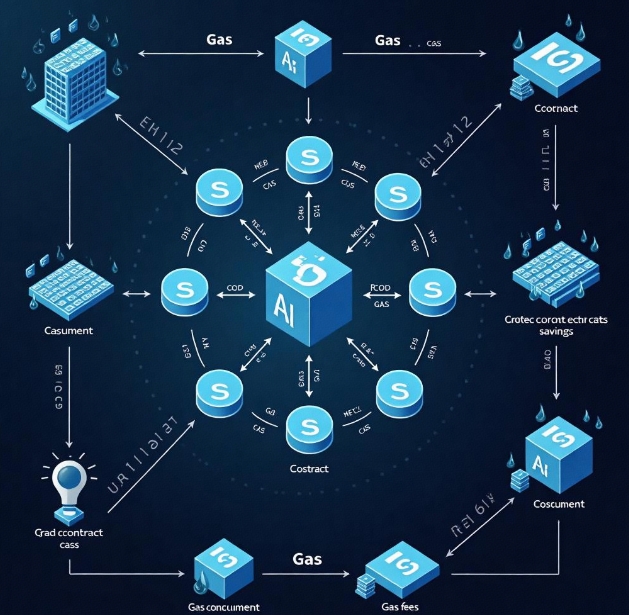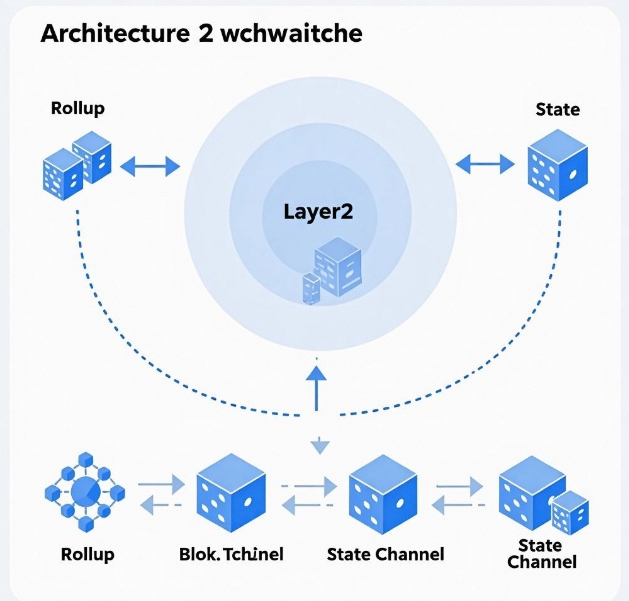How to optimize gas fees in Web3 development? Cost reduction strategies and techniques
- latest articles
- 1.DApp Development & Customization: Merging Diverse Market Needs with User Experience 2.Analysis of the Core Technical System in DApp Project Development 3.How to achieve cross-chain interoperability in Web3 projects? 4.How does the tokenization of points reconstruct the e-commerce ecosystem? 5.How to Set and Track Data Metrics for a Points Mall? 6.What is DApp Development? Core Concepts and Technical Analysis 7.Inventory of commonly used Web3 development tools and usage tips 8.Development of a Distribution System Integrated with Social E-commerce 9.Six Key Steps for Businesses to Build a Points Mall System 10.What is DApp Development? A Comprehensive Guide from Concept to Implementation
- Popular Articles
- 1.Future Trends and Technology Predictions for APP Development in 2025 2.Analysis of the DeFi Ecosystem: How Developers Can Participate in Decentralized Finance Innovation 3.From Zero to One: How PI Mall Revolutionizes the Traditional E-commerce Model 4.DAPP Development | Best Practices for Professional Customization and Rapid Launch 5.Recommended by the Web3 developer community: the most noteworthy forums and resources 6.From Cloud Computing to Computing Power Leasing: Building a Flexible and Scalable Computing Resource Platform 7.How to Develop a Successful Douyin Mini Program: Technical Architecture and Best Practices 8.Shared Bike System APP: The Convenient Choice in the Era of Smart Travel 9.How to Create a Successful Dating App: From Needs Analysis to User Experience Design 10.From Design to Development: The Complete Process of Bringing an APP Idea to Life
With the continuous development of blockchain technology, Web3, as a core component of the new generation of decentralized networks, has demonstrated immense potential across various fields. However, as blockchain becomes more widespread, especially on public chains like Ethereum, the issue of Gas fees has gradually become a significant challenge that cannot be ignored. Gas fees, which are the computational and storage resource costs required to execute smart contracts and transactions, often represent a substantial cost burden for both developers and users. Effectively optimizing Gas fees in Web3 development to reduce costs is a crucial challenge currently faced by blockchain developers.
This article will explore how to optimize Gas fees in Web3 development, introduce strategies and techniques for reducing Gas fees, and analyze common optimization methods to help developers lower costs while improving application performance and user experience.
I. Basic Concepts of Gas Fees
Gas is the unit of measurement for computational resources in transactions and operations on smart contract platforms like Ethereum. Whenever a user executes a transaction or calls a smart contract, a certain amount of Gas is consumed. Gas fees consist of two components: Gas Limit and Gas Price. Gas Limit refers to the maximum amount of Gas allowed to be consumed in a single operation, while Gas Price is the price per unit of Gas (denominated in ETH).
The level of Gas fees is directly influenced by the following factors:
Transaction Type and Complexity: Different transactions and smart contract operations require varying amounts of Gas. For example, a simple ETH transfer requires significantly less Gas than a complex smart contract call.
Blockchain Network Congestion: When the network is congested, Gas prices rise significantly as users need to pay higher prices to prioritize their transactions.
Degree of Contract Optimization: Unreasonable or inefficient contract code can lead to excessive Gas consumption, making code optimization crucial.
Therefore, optimizing Gas fees is not just about reducing the cost per transaction but also about considering how to minimize Gas consumption and improve transaction efficiency during the development process.
II. Strategies and Techniques for Reducing Gas Fees in Web3 Development
1. Optimizing Smart Contract Code
Smart contracts are the core of Web3 development, and their design and implementation directly determine Gas consumption. Therefore, optimizing smart contract code is the primary strategy for reducing Gas fees.
1.1 Reducing Unnecessary State Storage
On blockchains like Ethereum, storing state variables in smart contracts is often one of the most expensive operations. Each modification of the storage state consumes a significant amount of Gas. Therefore, developers should avoid frequent state updates and can reduce storage operations through the following methods:
Reduce Global State Variables: Minimize the number of variables that need to be stored on the blockchain, storing less important variables in external databases or on the client side.
Use Memory Variables Instead of Storage Variables: Operations on data in memory are cheaper than those on data in storage, so memory variables can be used to store intermediate data instead of frequently writing to storage.
Optimize Data Structures: Choose appropriate data structures to reduce storage space usage. For example, use
mappinginstead ofarray, as accessing and modifyingmappingis generally more efficient.
1.2 Streamlining Contract Logic
The more complex the execution logic of a smart contract, the more Gas it consumes. Therefore, streamlining contract logic is an effective way to reduce Gas fees.
Avoid Multiple Loops: Loops are a major source of Gas consumption, especially when the number of iterations is large. Minimize the use of loops or move computations off-chain.
Separate Complex Operations: Break down complex computational operations into multiple steps to avoid executing large amounts of computation at once. Complex contract functions can be decomposed into multiple sub-contracts for calls, thereby distributing Gas costs.
1.3 Using Events Instead of Return Values
In smart contracts, return values increase Gas consumption. For operations that only need to record state, events can be used instead of return values. Events are lightweight on the blockchain and do not consume as much Gas as storing state, thus significantly reducing costs.
2. Choosing the Right Gas Price
Gas Price is an important factor affecting transaction fees. In blockchain networks, Gas Price fluctuates with network congestion; typically, when the network is busy, Gas Price increases significantly. Developers can optimize Gas Price selection in the following ways.
2.1 Optimizing Transaction Timing
Gas prices usually vary over time. During periods of low network activity, Gas prices are relatively lower, so transactions can be submitted outside of peak hours to reduce Gas fees. Optimizing transaction timing can effectively lower transaction costs.
2.2 Dynamic Gas Pricing
Many Web3 development platforms (such as MetaMask, Hardhat, etc.) offer dynamic Gas pricing features that automatically adjust Gas prices based on current network conditions. Developers can leverage these tools to optimize Gas Price when initiating transactions according to real-time network conditions, thereby reducing transaction costs.
3. Using Layer 2 Solutions
Layer 2 solutions enhance blockchain throughput and efficiency while reducing transaction Gas fees by building secondary protocols on top of the main chain. Compared to traditional Ethereum mainnet, Layer 2 can significantly lower transaction fees.
3.1 Rollups Technology
Rollups are one of the most popular Layer 2 solutions today, primarily consisting of two types: Optimistic Rollups and ZK-Rollups. By batching a large number of transactions into a single transaction, Rollups reduce the Gas fee per transaction. For example, Optimistic Rollups process transactions in batches, while ZK-Rollups enhance transaction efficiency and security through zero-knowledge proofs. Both can significantly lower Gas fees and improve the overall network throughput.
3.2 State Channels
State channels are another common Layer 2 solution that allows participants to conduct multiple transactions off-chain, with only the final transaction result submitted to the main chain. By reducing on-chain operations, state channels can substantially lower Gas fees, making them suitable for applications requiring frequent interactions, such as payment channels or games.
4. Choosing the Right Public Chain and Optimizing Gas Fees
In addition to Ethereum, there are many other public chains that support smart contract development, such as Binance Smart Chain (BSC), Polygon, Avalanche, etc. These chains typically employ different consensus mechanisms and Gas fee models, resulting in lower Gas fees compared to Ethereum. Developers can choose the appropriate public chain to deploy smart contracts based on project requirements and budgets, further reducing Gas fees.
III. Practical Cases of Reducing Gas Fees
1. Optimization Case in DeFi Protocols
DeFi protocols (Decentralized Finance) are among the most popular applications in the Web3 space. In DeFi protocols, high transaction volumes and frequent interactions make Gas fees a major concern for users and developers. For example, Uniswap, as a decentralized exchange platform, optimizes transaction fees through streamlined contract code and dynamic Gas price adjustments. Uniswap V3 effectively reduces Gas fees per transaction by introducing concentrated liquidity and different fee tiers.
2. Optimization Case in NFT Platforms
The NFT (Non-Fungible Token) market is also an important application scenario for Gas fee optimization. Many NFT platforms (such as OpenSea, Rarible) adopt solutions similar to Layer 2 or optimize contract designs to reduce Gas consumption for each NFT minting or transaction. By minimizing storage and computational requirements, NFT platforms can offer users a lower-cost trading experience.
IV. Summary
The issue of Gas fees in Web3 development is a challenge that cannot be overlooked, but through strategies such as optimizing smart contracts, selecting appropriate Gas prices, utilizing Layer 2 solutions, and choosing public chains with lower Gas fees, developers can effectively reduce Gas costs. This not only lowers development and operational expenses but also enhances user experience, enabling decentralized applications to be more widely adopted and developed. In the future, with continuous technological advancements and innovations, Gas fee optimization in Web3 will become more mature, helping blockchain technology expand into broader application scenarios.
-

How to achieve cross-chain interoperability in Web3 projects?
With the continuous development of WEB3 technology, Web3 has gradually become an···
-

Inventory of commonly used Web3 development tools and usage tips
With the continuous development of blockchain technology, Web3 has become a hot ···
-

Web3 development trend prediction: analysis of future technology directions and application scenarios
With the gradual development of blockchain technology, the concept of Web3 has m···

 Blockchain
Blockchain












